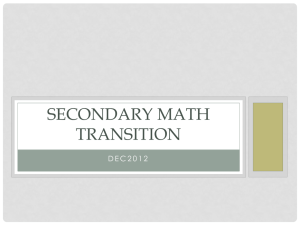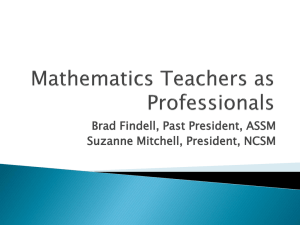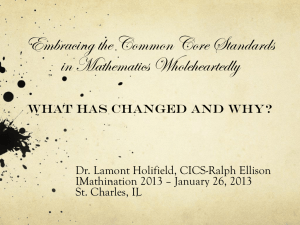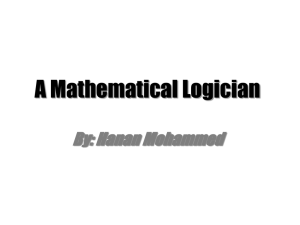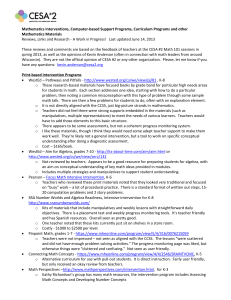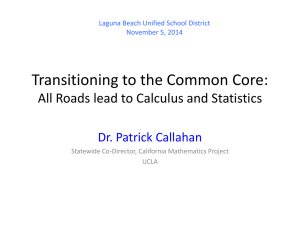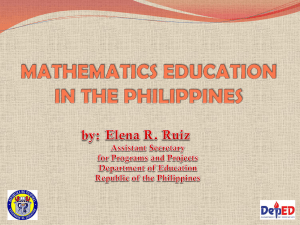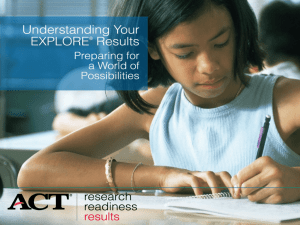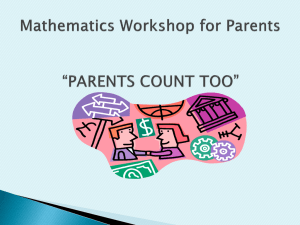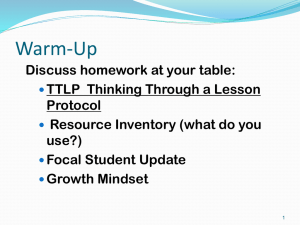presentation
advertisement
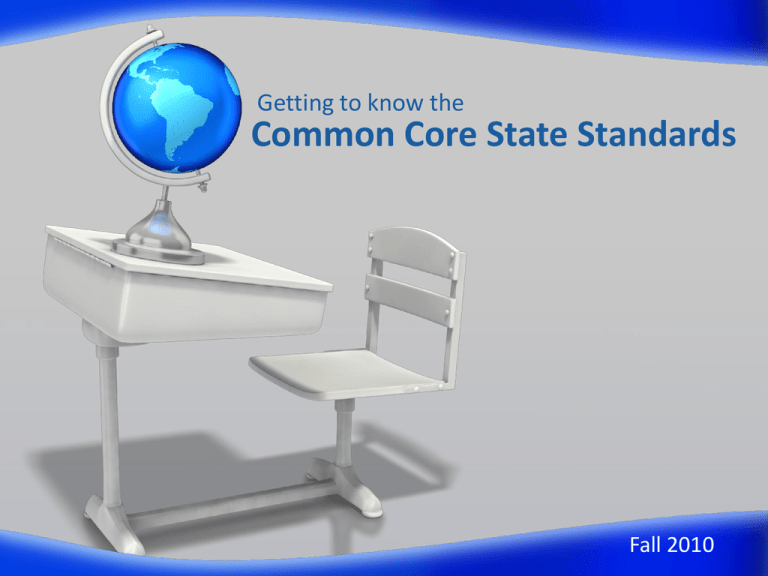
Getting to know the Common Core State Standards Fall 2010 Key Features “Career and College Readiness” aligned clear rigorous Aligned with college and work expectations Clear, understandable, and consistent Rigorous content and application of knowledge through higher-order skills better Built upon strengths and lessons of current state standards global Informed by other top-performing countries so that all students are prepared to succeed in the global economy From CCSS website CCSS for Mathematics Grade-Level Standards • K-8 grade-by-grade standards organized by domain • 9-12 high school standards organized by conceptual categories Standards for Mathematical Practice • Describe mathematical “habits of mind” • Standards for mathematical proficiency: reasoning, problem solving, modeling, decision making, and engagement • Connect with content standards in each grade Mathematics K-8 The K- 8 standards: • The K-5 standards provide students with a solid foundation in whole numbers, addition, subtraction, multiplication, division, fractions and decimals • The 6-8 standards describe robust learning in geometry, algebra, and probability and statistics • Modeled after the focus of standards from high-performing nations, the standards for grades 7 and 8 include significant algebra and geometry content • Students who have completed 7th grade and mastered the content and skills will be prepared for algebra, in 8th grade or after Mathematics HS The High School standards: • Call on students to practice applying mathematical ways of thinking to real world issues and challenges • Require students to develop a depth of understanding and ability to apply mathematics to novel situations, as college students and employees regularly are called to do • Emphasize mathematical modeling, the use of mathematics and statistics to analyze empirical situations, understand them better, and improve decisions • Identify the mathematics that all students should study in order to be college and career ready. Compare a high-deductible versus a low-deductible automobile insurance policy using various, but reasonable, chances of having a minor or a major accident. Compare a high-deductible versus a low-deductible automobile insurance policy using various, but reasonable, chances of having a minor or a major accident. Courses in higher level mathematics: Precalculus, Calculus (upon completion of Precalculus), Advanced Statistics, Discrete Mathematics, Advanced Quantitative Reasoning, or other courses to be designed at a later date, such as additional career technical courses. Algebra II Mathematics III Geometry Mathematics II Algebra I Mathematics I CCSS for ELA College and Career Readiness (CCR) Standards • Overarching standards for each strand that are further defined by grade-specific standards Grade-Level Standards in English Language Arts • K-8, grade-by-grade • 9-10 and 11-12 grade bands for high school • Four strands: Reading, Writing, Speaking and Listening, and Language Standards for Literacy • Standards are embedded at grades K-5 • Content-specific literacy standards are provided for grades 6-8, 9-10, and 11-12 Reading Strand Progressive development of reading comprehension; students gain more from what they read Emphasize the importance of grade-level texts that are of appropriate difficulty and are increasingly sophisticated • Standards for Reading Foundational Skills (K-5) • Reading Standards for Literature (K-12) • Reading Standards for Informational Text (K-12) • Reading Standards for Literacy in History/Social Studies (6-12) • Reading Standards for Literacy in Science and Technical Subjects (6-12) Being Deliberate About Reading Levels Interquartile Ranges Shown (25% - 75%) 1600 Text Lexile Measure (L) 1400 1200 1000 800 600 High School Literature College Literature College High School Textbooks Textbooks Military Personal Entry-Level Use Occupations SAT 1, ACT, AP* From: Datametrics Writing Strand Writing • Expect students to compose arguments and opinions, informative/explanatory pieces, and narrative texts • Focus on the use of reason and evidence to substantiate an argument or claim • Emphasize ability to conduct research – short projects and sustained inquiry • Require students to incorporate technology as they create, refine, and collaborate on writing • Include student writing samples that illustrate the criteria required to meet the standards Speaking and Listening Strand Speaking and Listening • Focus on speaking and listening in a range of settings, both formal and informal – academic, small-group, whole-class discussions • Emphasize effective communication practices • Require interpretation and analysis of message as presented through oral, visual, or multimodal formats Media and Technology are integrated throughout the standards. Language Strand Language • Include conventions for writing and speaking • Highlight the importance of vocabulary acquisition through a mix of conversation, direct instruction, and reading • To be addressed in context of reading, writing, speaking and listening Media and Technology are integrated throughout the standards. Students determine John Adams’ point of view in his “Letter on Thomas Jefferson” and analyze how he distinguishes his position from an alternative approach articulated by Thomas Jefferson. Students determine John Adams’ point of view in his “Letter on Thomas Jefferson” and analyze how he distinguishes hisHigh position School? from an alternative approach articulated by Thomas Jefferson. Students determine John Adams’ point of view in his “Letter on Thomas Jefferson” and analyze Seventh how he distinguishes his position Grade! from an alternative approach articulated by Thomas Jefferson. [RI.7.6] Key Advances reading Balance of literature and informational texts Text complexity writing Emphasis on argument and informative/explanatory writing Writing about sources speaking Inclusion of formal and informal talk language Stress on general academic and domain-specific vocabulary technology Media and technology are integrated throughout the standards. From CCSS website CCSS for History/Social Studies, Science, and Technical Subjects Reading • Knowledge of domain-specific vocabulary • Analyze, evaluate, and differentiate primary and secondary sources • Synthesize quantitative and technical information, including facts presented in maps, timelines, flowcharts, or diagrams Writing • Write arguments on discipline-specific content and informative/explanatory texts • Use of data, evidence, and reason to support arguments and claims • Use of domain-specific vocabulary Now what? who Who will do the realignment work and develop assessments? what What steps will be taken to align, implement, and assess? when When should you change, considering the assessment schedule why Why use the [forthcoming] state/consortia curricula? how How will this effect classrooms, assessments, adoption of resources, differentiation, etc.? From CCSS website Getting to know the Common Core State Standards Fall 2010

